Bond Properties of Steel Bar in Concrete under Water Environment
Abstract
:1. Introduction
2. Experimental Study
2.1. Details of Specimen
2.2. Specimens Soaked under Water
2.3. Pull-Out Test
3. Results and Discussion
3.1. Failure Models
3.2. Moisture Content and Concrete Strength
3.3. Bond–Slip Curves
3.4. Bond Strength and Slip
3.5. Bond–Slip Constitutive Model
4. Conclusions
- (1)
- The moisture content increased with the soaking time owing to the penetration of environmental water into macroscope pores and cracks of concrete. A higher moisture content was reached in concrete with lower compressive strength. This induced the different changes of concrete with soaking time. Different from the exponential relationship between tensile strength and compressive strength of concrete under normal environmental conditions, the tensile strength of concrete under a water environment was linear with the compressive strength. On the basis of the test data of this study, the predictive formulas for the compressive and splitting tensile strengths of concrete under a water environment are proposed with the influencing factor of soaking time.
- (2)
- Except for a few specimens that failed with the splitting of concrete, most specimens failed with the pulling out of steel bar owing to the confining of stirrups. The bond–slip curve has a complete descending stage. As the key points of the research objectives, the bond strength, residual bond strength, and corresponding slip are provided, and the predictive formulas are built considering the soaking time.
- (3)
- The constitutive model of bond–slip with ascent and descent portions for the steel bar in concrete under a water environment is proposed, and the relevant parameters considering the soaking time are provided. The comparison with experimental bond–slip curves is exhibited to indicate the applicability of the proposed model.
Author Contributions
Funding
Conflicts of Interest
Appendix A
| Specimen No. | Moisture Content (%) | fcu (N/mm2) | ft (N/mm2) | τu (N/mm2) | su (mm) | τr (N/mm2) |
|---|---|---|---|---|---|---|
| A28–1 | 5.42 | 32.26 | 2.82 | 13.89 | 1.598 | 3.09 |
| A28–2 | 5.42 | 32.26 | 2.82 | 13.00 | 1.881 | 3.15 |
| A28–3 | 5.42 | 32.26 | 2.82 | 13.99 | 2.219 | – |
| A90–1 | 6.08 | 34.71 | 2.83 | 17.27 | 1.226 | 2.97 |
| A90–2 | 6.08 | 34.71 | 2.83 | 15.76 | 1.353 | 5.21 |
| A90–3 | 6.08 | 34.71 | 2.83 | 15.23 | 1.828 | 4.04 |
| A180–1 | 6.75 | 38.81 | 3.11 | 18.98 | 1.755 | 5.97 |
| A180–2 | 6.75 | 38.81 | 3.11 | 17.26 | 1.825 | 3.17 |
| A180–3 | 6.75 | 38.81 | 3.11 | 19.79 | 1.365 | 5.02 |
| A270–1 | 6.43 | 36.73 | 2.44 | 20.70 | 1.314 | 3.48 |
| A270–2 | 6.43 | 36.73 | 2.44 | 22.86 | 1.052 | 5.97 |
| A270–3 | 6.43 | 36.73 | 2.44 | 22.94 | 1.315 | 5.54 |
| A360–1 | 6.91 | 46.87 | 3.16 | 20.43 | 0.879 | 3.81 |
| A360–2 | 6.91 | 46.87 | 3.16 | 19.62 | 1.427 | 5.13 |
| A360–3 | 6.91 | 46.87 | 3.16 | 18.25 | 1.154 | 5.24 |
| B28–1 | 2.81 | 45.68 | 3.77 | 21.73 | 1.276 | 2.46 |
| B28–2 | 2.81 | 45.68 | 3.77 | 20.19 | 1.489 | 2.89 |
| B28–3 | 2.81 | 45.68 | 3.77 | 18.64 | 0.782 | 2.34 |
| B90–1 | 3.34 | 49.19 | 4.42 | 22.77 | 1.34 | 5.03 |
| B90–2 | 3.34 | 49.19 | 4.42 | 22.75 | 0.979 | 3.23 |
| B90–3 | 3.34 | 49.19 | 4.42 | 21.81 | – | – |
| B180–1 | 4.40 | 52.95 | 4.83 | 23.21 | 0.975 | 7.46 |
| B180–2 | 4.40 | 52.95 | 4.83 | 26.19 | 0.811 | 4.81 |
| B180–3 | 4.40 | 52.95 | 4.83 | 21.62 | 0.865 | 5.74 |
| B270–1 | 3.98 | 51.88 | 3.76 | 21.66 | 1.539 | 7.35 |
| B270–2 | 3.98 | 51.88 | 3.76 | 26.77 | 0.586 | 5.37 |
| B270–3 | 3.98 | 51.88 | 3.76 | 25.96 | 1.242 | 3.12 |
| B360–1 | 4.36 | 58.69 | 4.55 | 22.67 | 1.096 | 2.35 |
| B360–2 | 4.36 | 58.69 | 4.55 | 20.48 | 0.683 | 5.70 |
| B360–3 | 4.36 | 58.69 | 4.55 | 24.09 | 0.851 | 5.00 |
References
- Ministry of Housing and Urban-Rural Construction of the People’s Republic of China. Code for Durability Design of Concrete Structures; GB 50476-2008; China Building Industry Press: Beijing, China, 2008. (In Chinese) [Google Scholar]
- Ministry of Water Resources of the People’s Republic of China. Design Code for Hydraulic Concrete Structures; SL 191-2008; China WaterPower Press: Beijing, China, 2008. (In Chinese) [Google Scholar]
- Medjigbodo, S.; Choinska, M.; Regoin, J.P.; Loukili, A.; Khelidj, A. Experimental study of the air–steam mixture leakage rate through damaged and partially saturated concrete. Mater. Struct. 2016, 49, 843–855. [Google Scholar] [CrossRef]
- Wang, H.; Wang, L.C.; Song, Y.P.; Wang, J.Z. Influence of free water on dynamic behavior of dam concrete under biaxial compression. Constr. Build. Mater. 2016, 112, 222–231. [Google Scholar] [CrossRef]
- Wang, H.L.; Yin, W.W.; Cheng, X.D. Influence of water content on dynamic compressive properties of concrete subjected to seismic strain rate. J. Hydraul. Eng. 2019, 50, 225–232. (In Chinese) [Google Scholar]
- Kameche, Z.A.; Ghomari, F.; Choinska, M.; Khelidj, A. Assessment of liquid water and gas permeabilities of partially saturated ordinary concrete. Constr. Build. Mater. 2014, 65, 551–565. [Google Scholar] [CrossRef]
- Wu, S.X.; Chen, X.D.; Zhou, J.K. Influence of strain rate and water content on mechanical behavior of dam concrete. Constr. Build. Mater. 2012, 36, 448–457. [Google Scholar] [CrossRef]
- Peng, G.; Wang, Q.F.; Liang, C.H. Study on dynamic compressive properties of concrete under pore water pressure environment. China Civ. Eng. J. 2015, 48, 11–18. (In Chinese) [Google Scholar]
- Xu, S.L.; Wang, J.M. Crack propagation in a concrete dam under water pressure and determination of the double-K fracture parameters. China Civ. Eng. J. 2009, 42, 119–125. (In Chinese) [Google Scholar]
- Yaman, I.O.; Hearn, N.; Aktan, H.M. Active and non-active porosity in concrete part I: Experimental evidence. Mater. Struct. 2002, 35, 102–109. [Google Scholar] [CrossRef]
- Wang, H.L.; Li, Q.B. Effect of pore water on the compressive strength of wet concrete. Eng. Mech. 2006, 23, 141–144. (In Chinese) [Google Scholar]
- Hou, D.W.; Zhang, J.; Chen, H.Y.; Liu, W. Development of strength and elastic modulus of concrete under moisture and drying conditions. J. Hydraul. Eng. 2012, 43, 198–208. (In Chinese) [Google Scholar]
- Ding, X.X.; Li, C.Y.; Xu, Y.Y.; Li, F.L.; Zhao, S.B. Experimental study on long-term compressive strength development of concrete with manufactured sand. Constr. Build. Mater. 2016, 108, 67–73. [Google Scholar] [CrossRef]
- Zhao, S.B.; Ding, X.X.; Zhao, M.S.; Li, C.Y.; Pei, S.W. Experimental study on tensile strength development of concrete with manufactured sand. Constr. Build. Mater. 2017, 138, 247–253. [Google Scholar] [CrossRef]
- Li, C.Y.; Wang, F.; Deng, X.S.; Li, Y.Z.; Zhao, S.B. Testing and prediction of the strength development of recycled-aggregate concrete with large particle natural aggregate. Materials 2019, 12, 1891. [Google Scholar] [CrossRef] [PubMed]
- Farzampour, A. Temperature and humidity effects on behavior of grouts. Adv. Concr. Constr. 2017, 5, 659–669. [Google Scholar]
- Farzampour, A. Compressive behavior of concrete under environmental effects. In Compressive Strength of Concrete; IntechOpen: London, UK, 2019. [Google Scholar]
- Ministry of Housing and Urban-Rural Construction of the People’s Republic of China. Standard for Test Method of Mechanical Properties on Ordinary Concrete; GB/T 50081-2002; China Building Industry Press: Beijing, China, 2002. (In Chinese) [Google Scholar]
- Brara, A.; Klepaczko, J.R. Experimental characterization of concrete in dynamic tension. Mech. Mater. 2006, 38, 253–267. [Google Scholar] [CrossRef]
- Ross, C.A.; Jerome, D.M.; Tedesco, J.W.; Hughes, M.L. Moisture and strain rate effects on concrete strength. ACI Mater. J. 1996, 93, 293–300. [Google Scholar]
- Cadoni, E.; Labibes, K.; Albertini, C.; Berra, M.; Giangrasso, M. Strain-rate effect on the tensile behaviour of concrete at different relative humidity levels. Mater. Struct. 2001, 34, 21–26. [Google Scholar] [CrossRef]
- Wang, H.L.; Jin, W.L.; Li, Q.B. Saturation effect on dynamic tensile and compressive strength of concrete. Adv. Struct. Eng. 2009, 12, 279–286. [Google Scholar] [CrossRef]
- Yan, D.M.; Lin, G.; Wang, Z.; Zhang, Y.Q. Research on dynamic direct tensile properties of concrete under different environment. J. Dalian Univ. Tech. 2005, 45, 416–421. (In Chinese) [Google Scholar]
- Xu, Y.L.; Shen, W.D.; Wang, H. An experimental study of bond-anchorage properties of bars in concrete. J. Build. Struct. 1994, 15, 26–36. (In Chinese) [Google Scholar]
- Harajli, M.H. Development/splice strength of reinforcing bars embedded in plain and fiber reinforced concrete. ACI Struct. J. 1994, 91, 511–520. [Google Scholar]
- Darwin, D.; Zuo, J.; Tholen, M.L.; Idun, E.K. Development length criteria for conventional and high relative rib area reinforcing bars. ACI Struct. J. 1996, 93, 347–359. [Google Scholar]
- Ministry of Housing and Urban-Rural Construction of the People’s Republic of China. Standard for Testing Method of Concrete Structures; GB 50152-2012; China Building Industry Press: Beijing, China, 2012. (In Chinese) [Google Scholar]
- Ministry of Housing and Urban-Rural Construction of the People’s Republic of China. Design Code for Concrete Structures; GB 50010-2010; China Building Industry Press: Beijing, China, 2010. (In Chinese) [Google Scholar]
- Butler, L.; West, J.S.; Tighe, S.L. The effect of recycled concrete aggregate properties on the bond strength between RCA concrete and steel reinforcement. Cem. Concr. Res. 2011, 10, 1037–1049. [Google Scholar] [CrossRef]
- Prince, M.J.R.; Singh, B. Bond behaviour of deformed steel bars embedded in recycled aggregate concrete. Constr. Build. Mater. 2013, 49, 852–862. [Google Scholar] [CrossRef]
- Li, C.Y.; Zhao, M.L.; Ren, F.C.; Liang, N.; Li, J.; Zhao, M.S. Bond Properties between full-recycled-aggregate concrete and deformed steel bar. Open Civ. Eng. J. 2017, 11, 685–698. [Google Scholar] [CrossRef]
- Zhao, S.B.; Ding, X.X.; Li, C.M.; Li, C.Y. Experimental study of bond properties between deformed steel bar and concrete with machine-made sand. J. Build. Mater. 2013, 16, 193–199. (In Chinese) [Google Scholar]
- Zhao, M.S.; Zhang, X.Y.; Yan, K.; Fei, T.; Zhao, S.B. Bond performance of deformed rebar in steel fiber reinforced lightweight-aggregate concrete affected by multi-factors. Civ. Eng. J. 2018, 27, 276–290. [Google Scholar] [CrossRef]
- General Administration of Quality Supervision, Inspection and Quarantine of the People’s Republic of China. Common Portland Cement; GB 175-2007; China Standard Press: Beijing, China, 2007. (In Chinese) [Google Scholar]
- Ministry of Housing and Urban-Rural Construction of the People’s Republic of China. Standard for Technical Requirements and Test Method of Sand and Crushed Stone (or Gravel) for Ordinary Concrete; JGJ 52-2006; China Building Industry Press: Beijing, China, 2006. (In Chinese) [Google Scholar]
- Ministry of Housing and Urban-Rural Construction of the People’s Republic of China. Specification for Mix Proportion Design of Ordinary Concrete; JGJ 55-2011; China Building Industry Press: Beijing, China, 2011. (In Chinese) [Google Scholar]
- Ministry of Housing and Urban-Rural Construction of the People’s Republic of China. Technical Specification of Lightweight Aggregate Concrete; JGJ 51-2002; China Building Industry Press: Beijing, China, 2002. (In Chinese) [Google Scholar]
- Ministry of Water Resources of the People’s Republic of China. Test Code for Hydraulic Concrete; SL 352-2006; China Water Power Press: Beijing, China, 2006. (In Chinese) [Google Scholar]
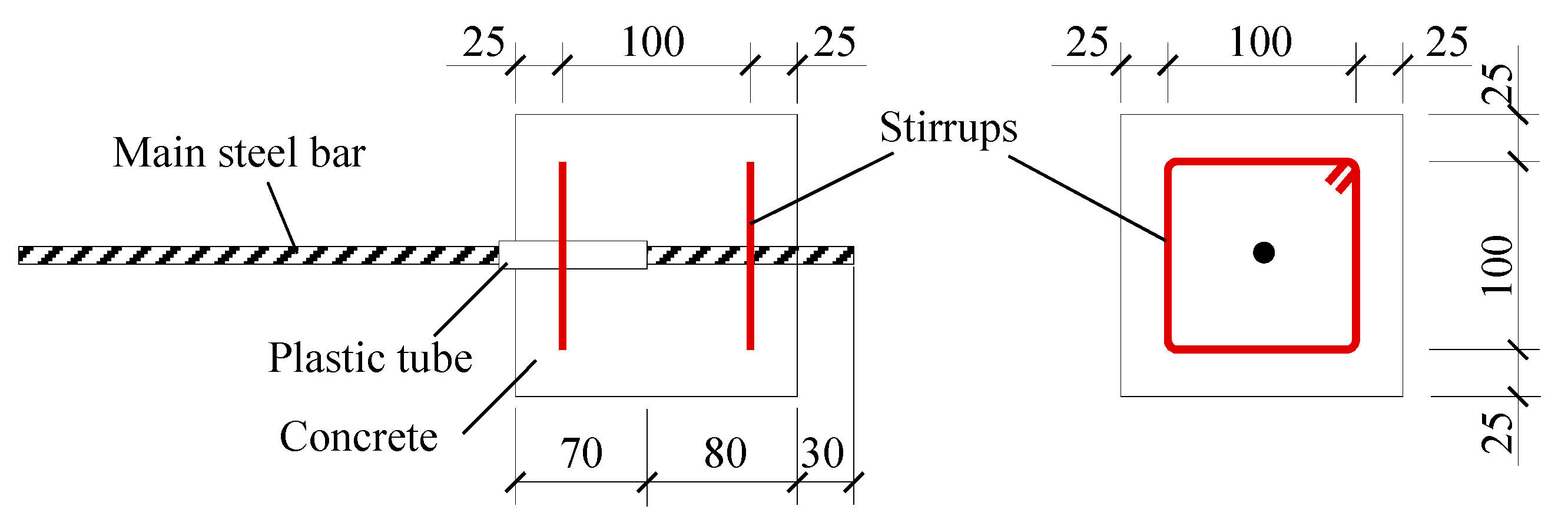
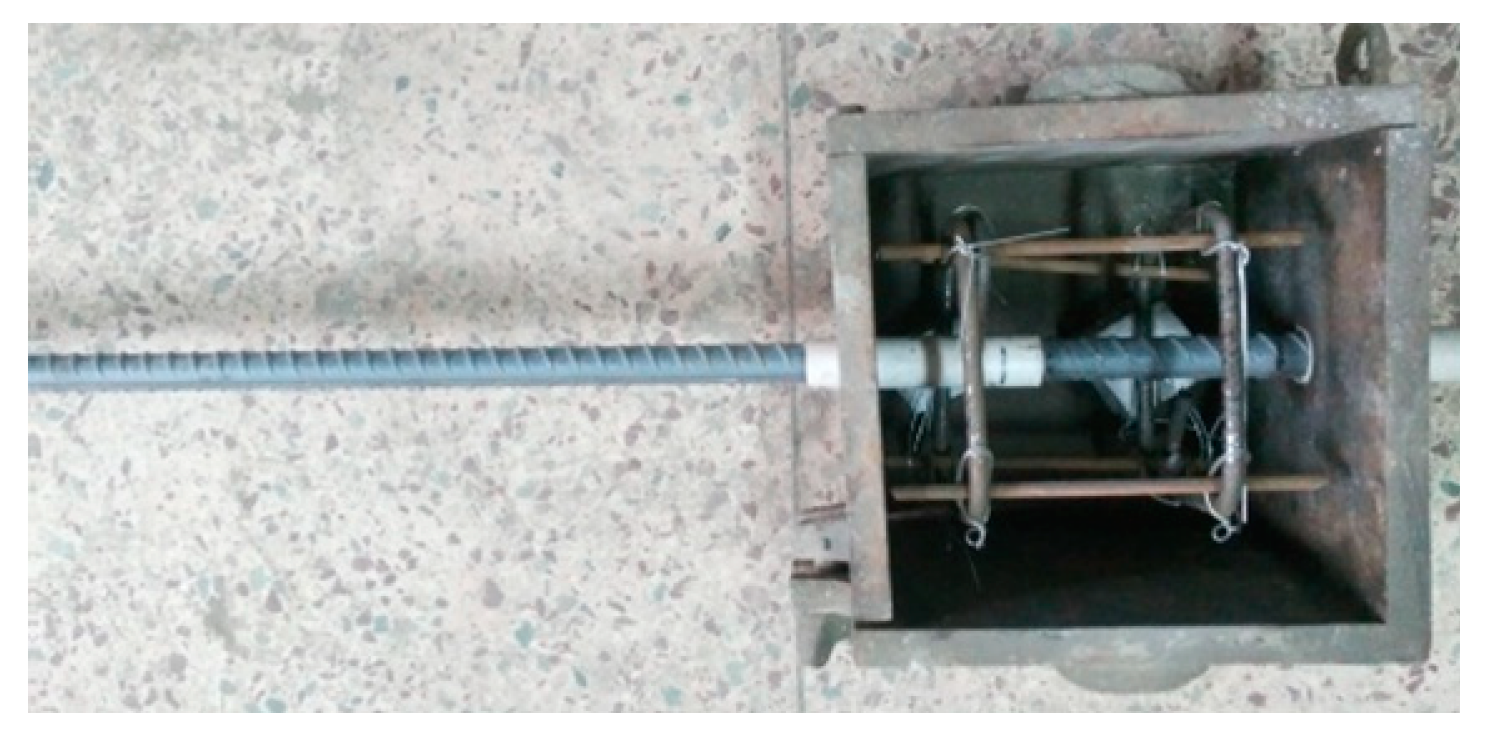

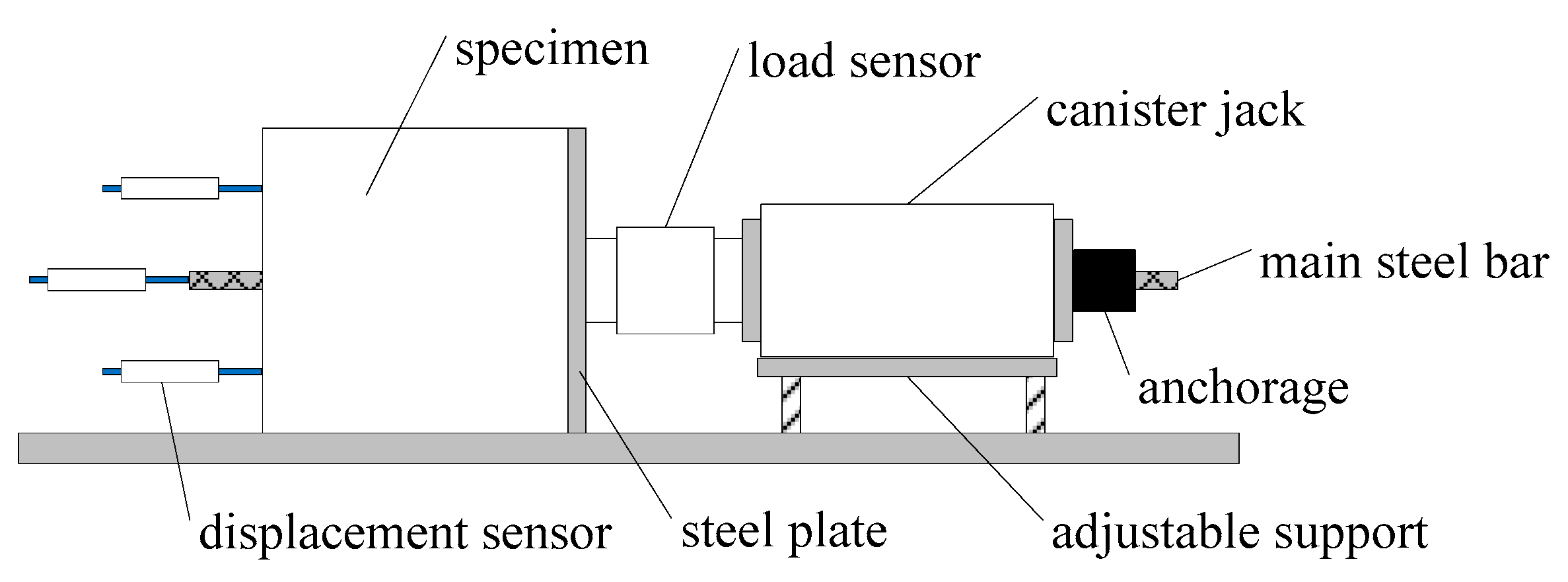
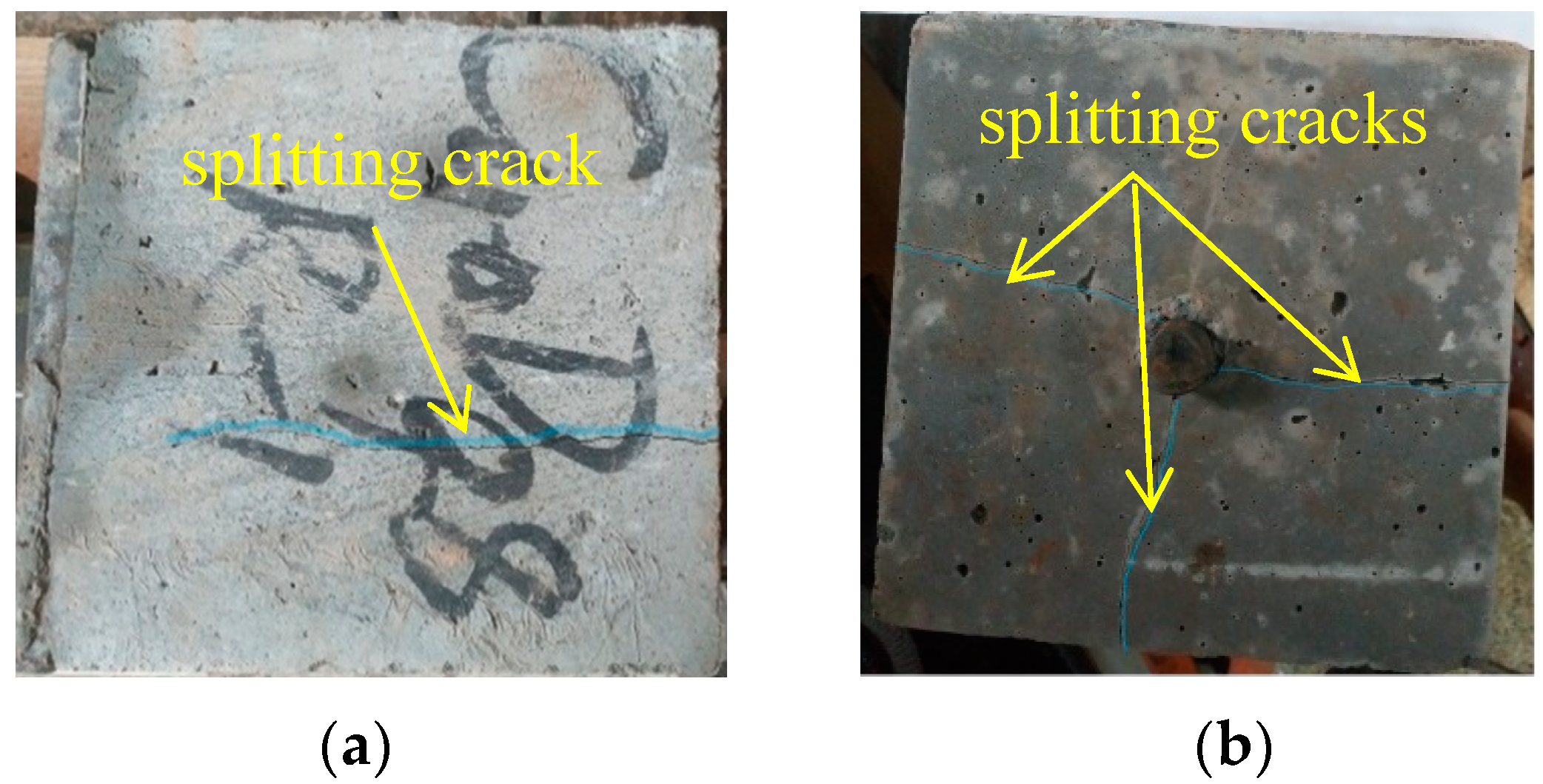
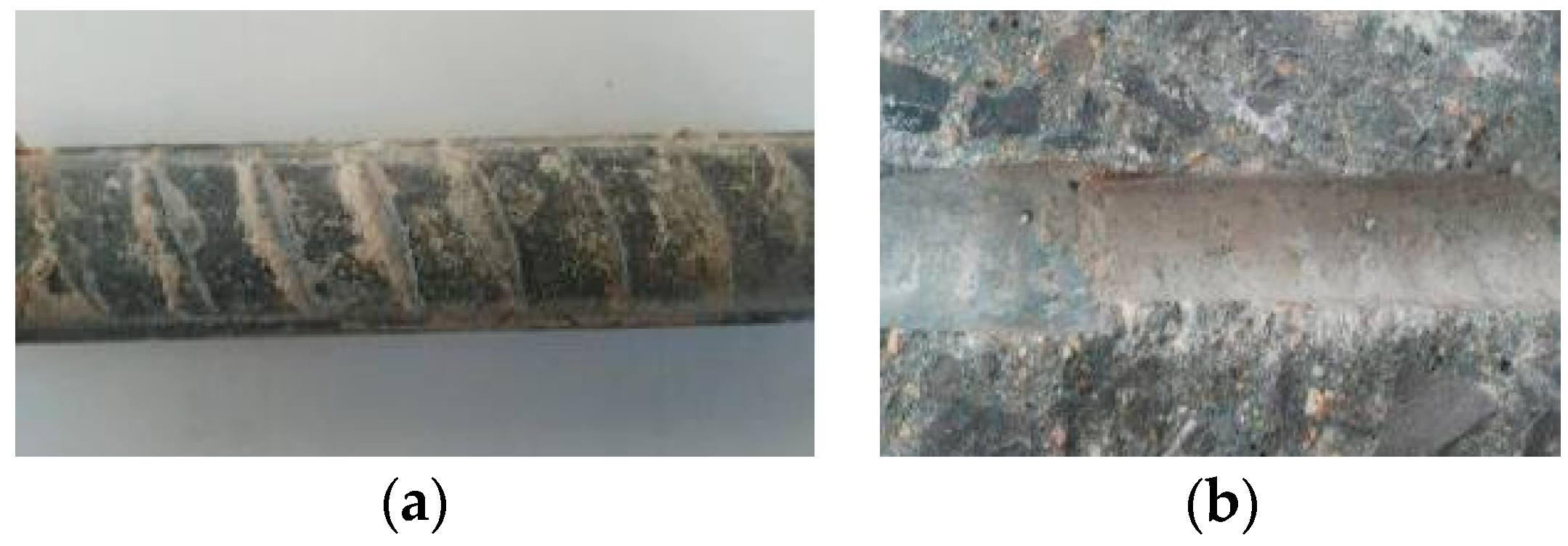


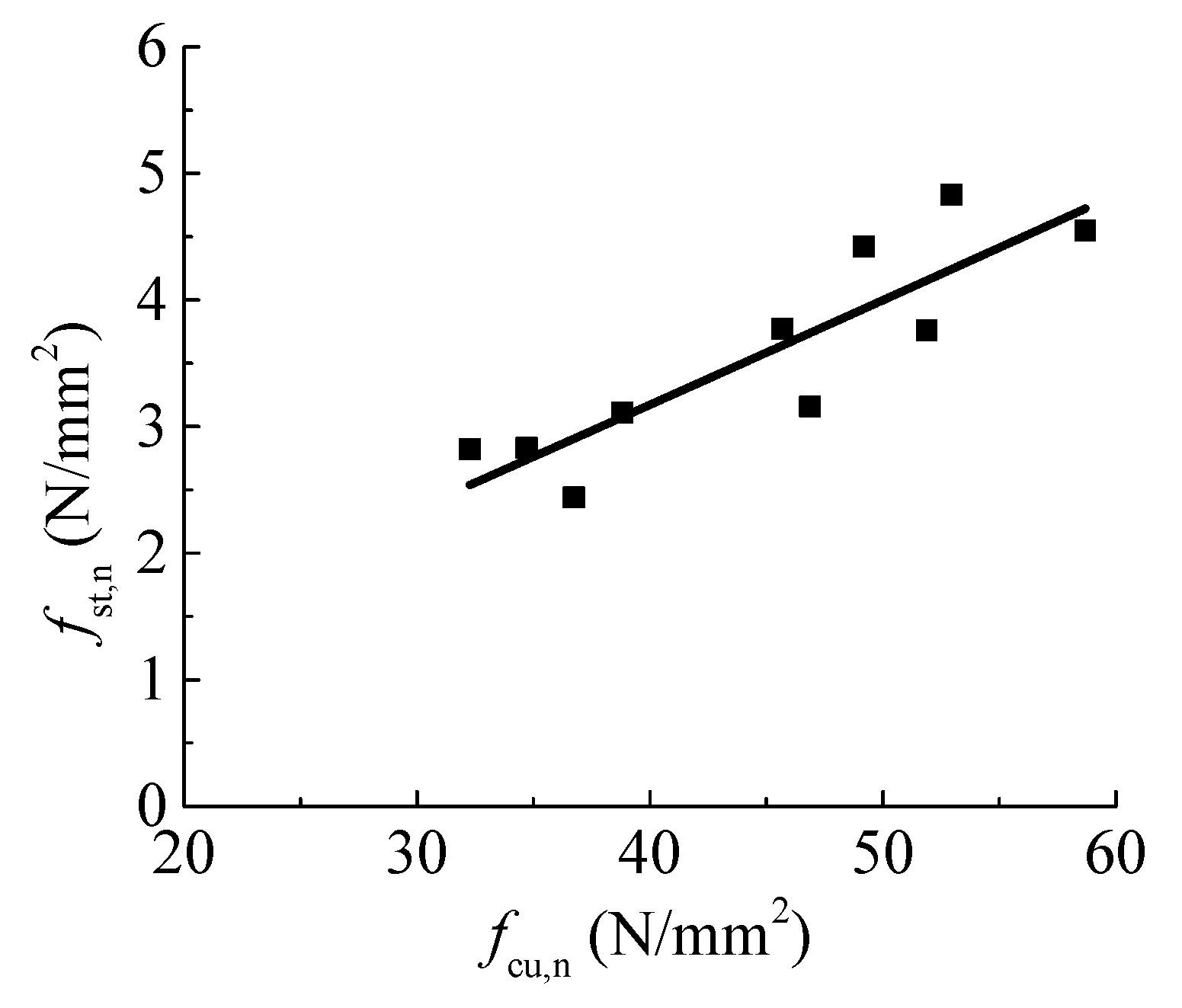
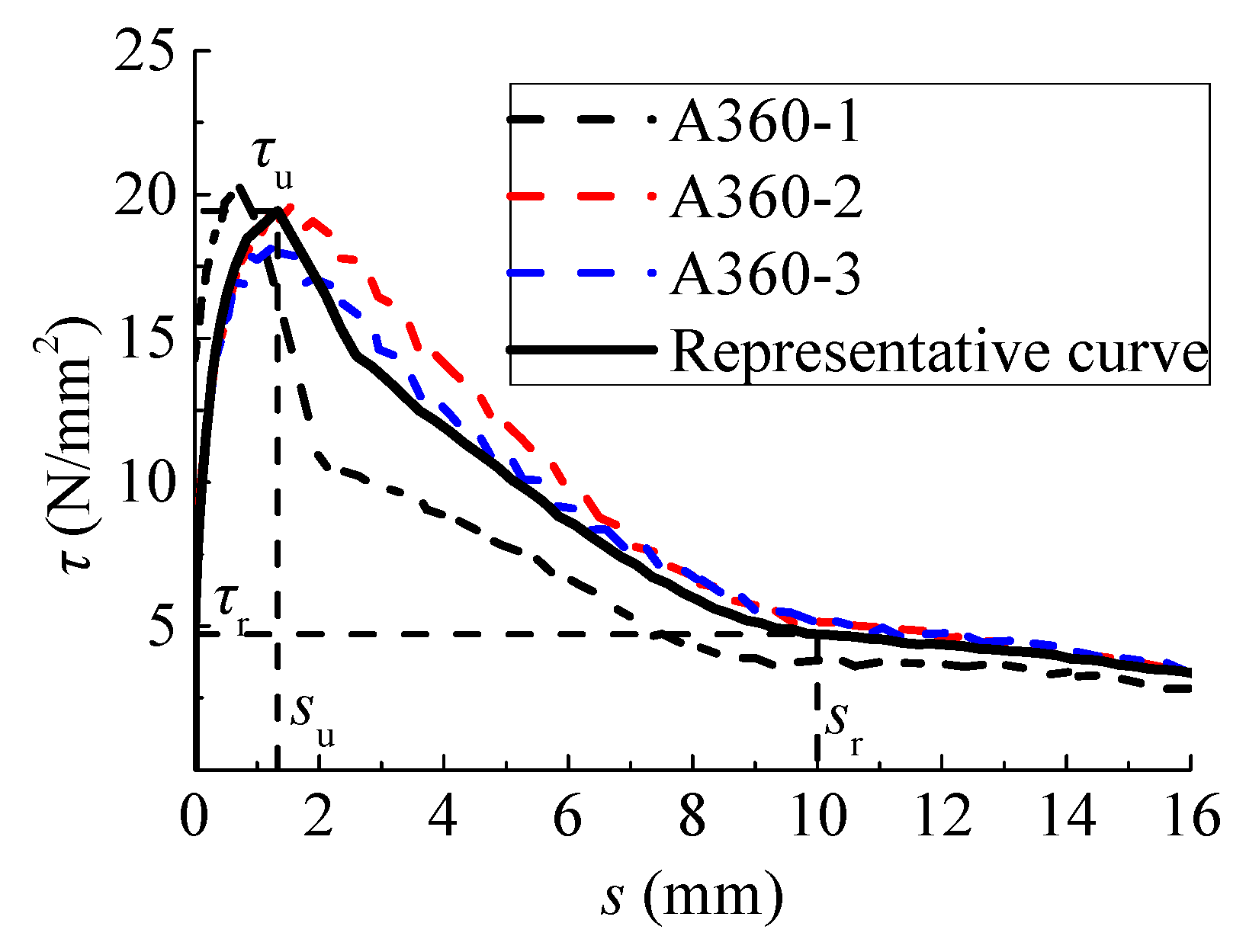
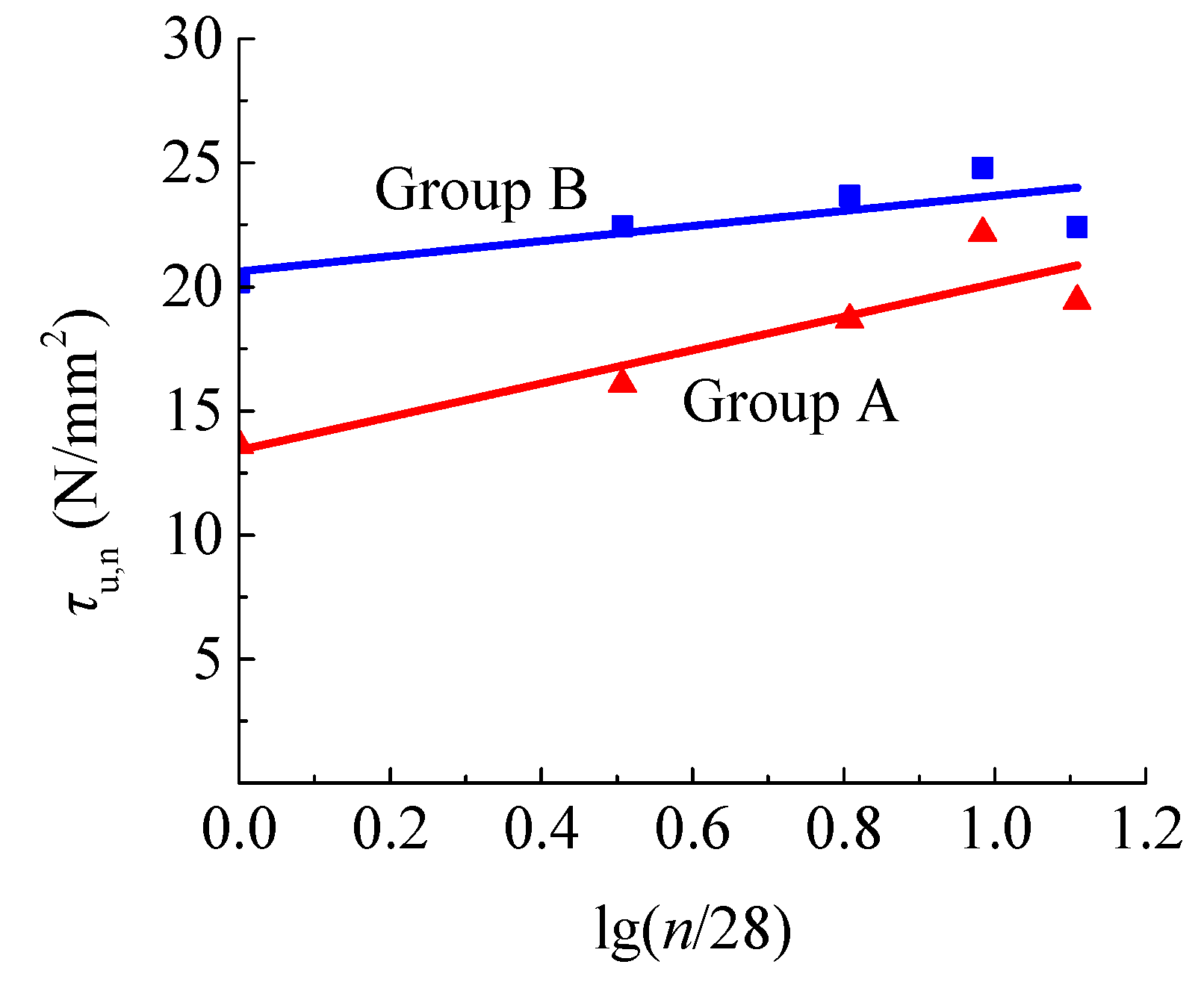
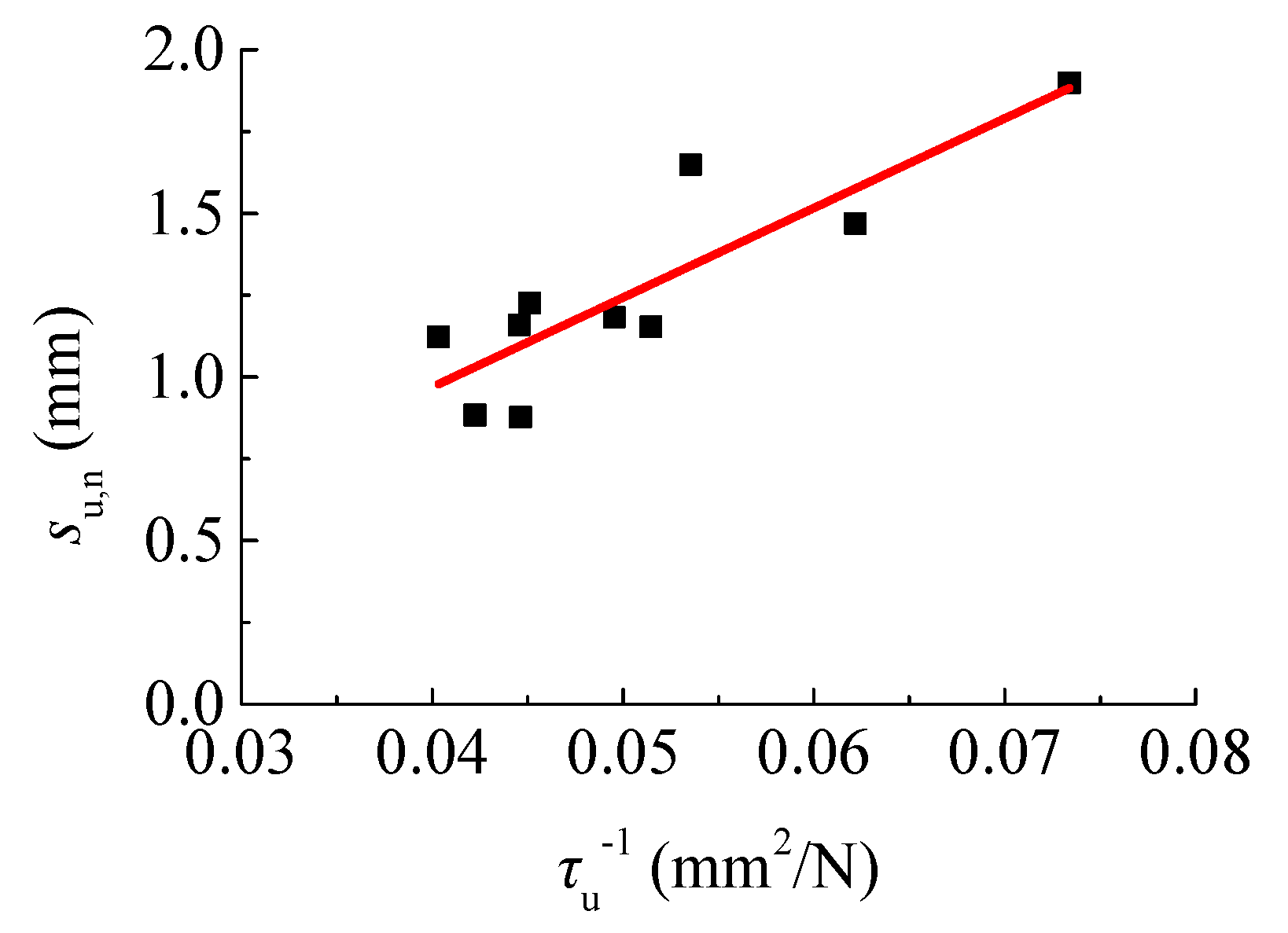
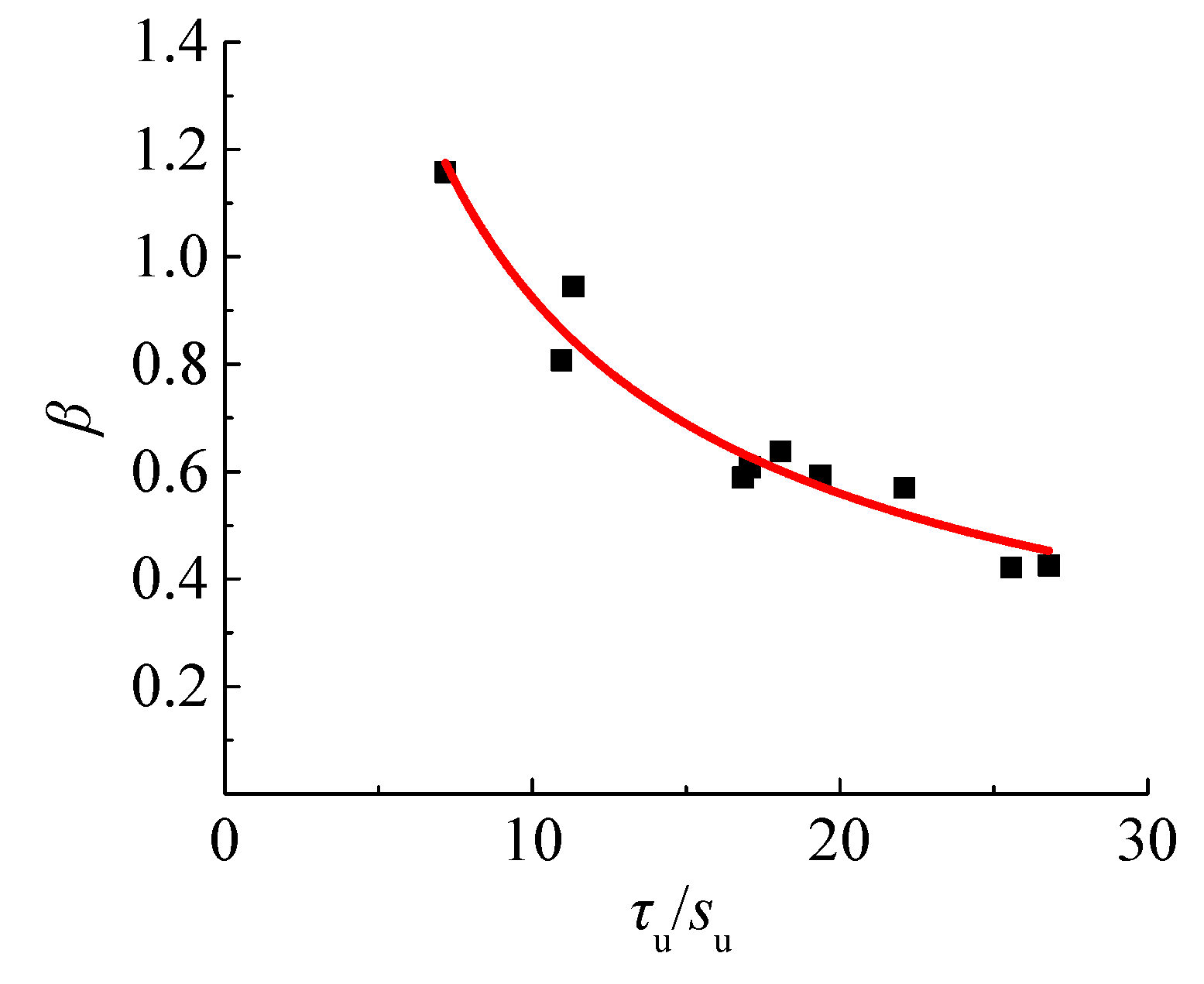
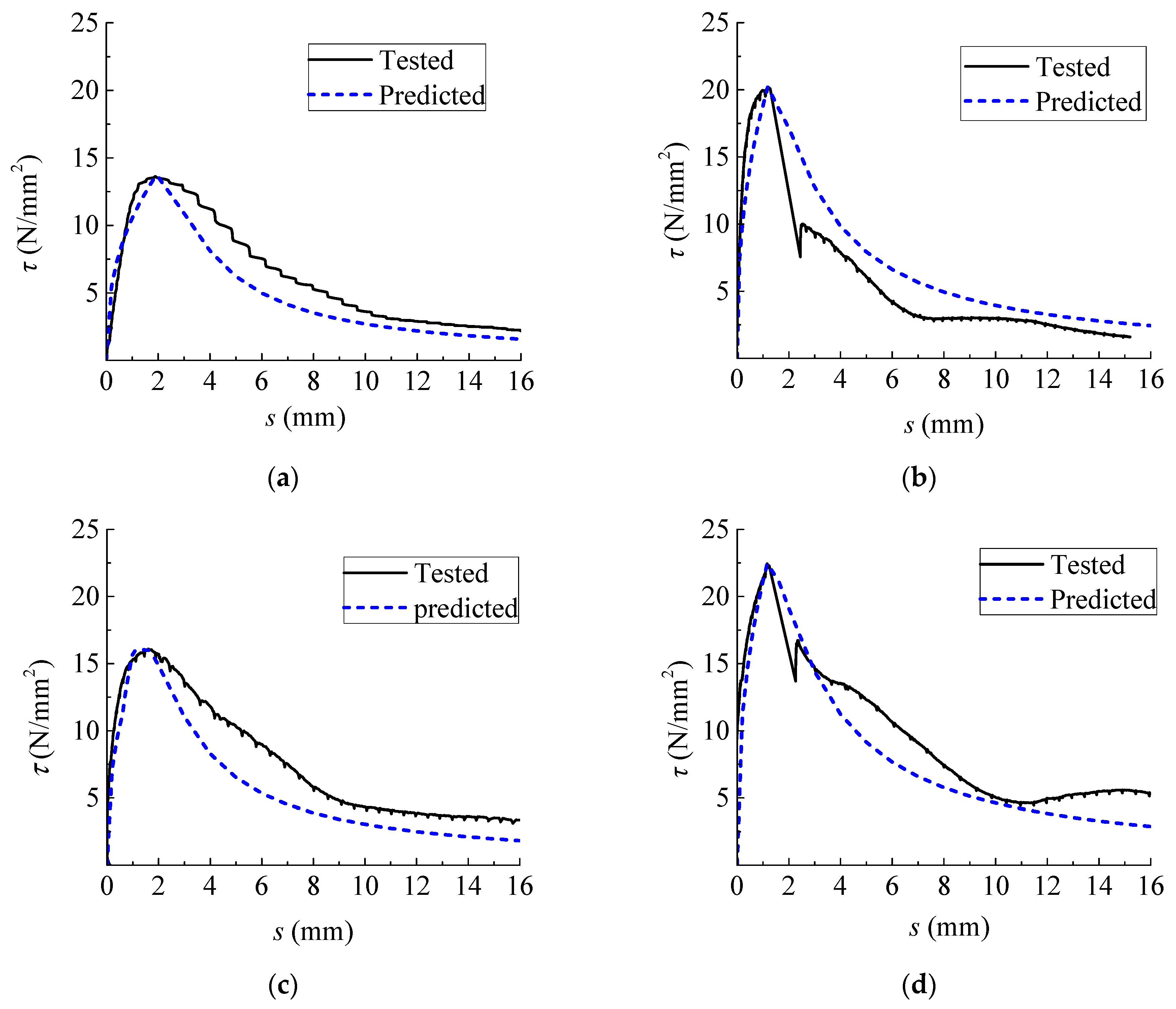
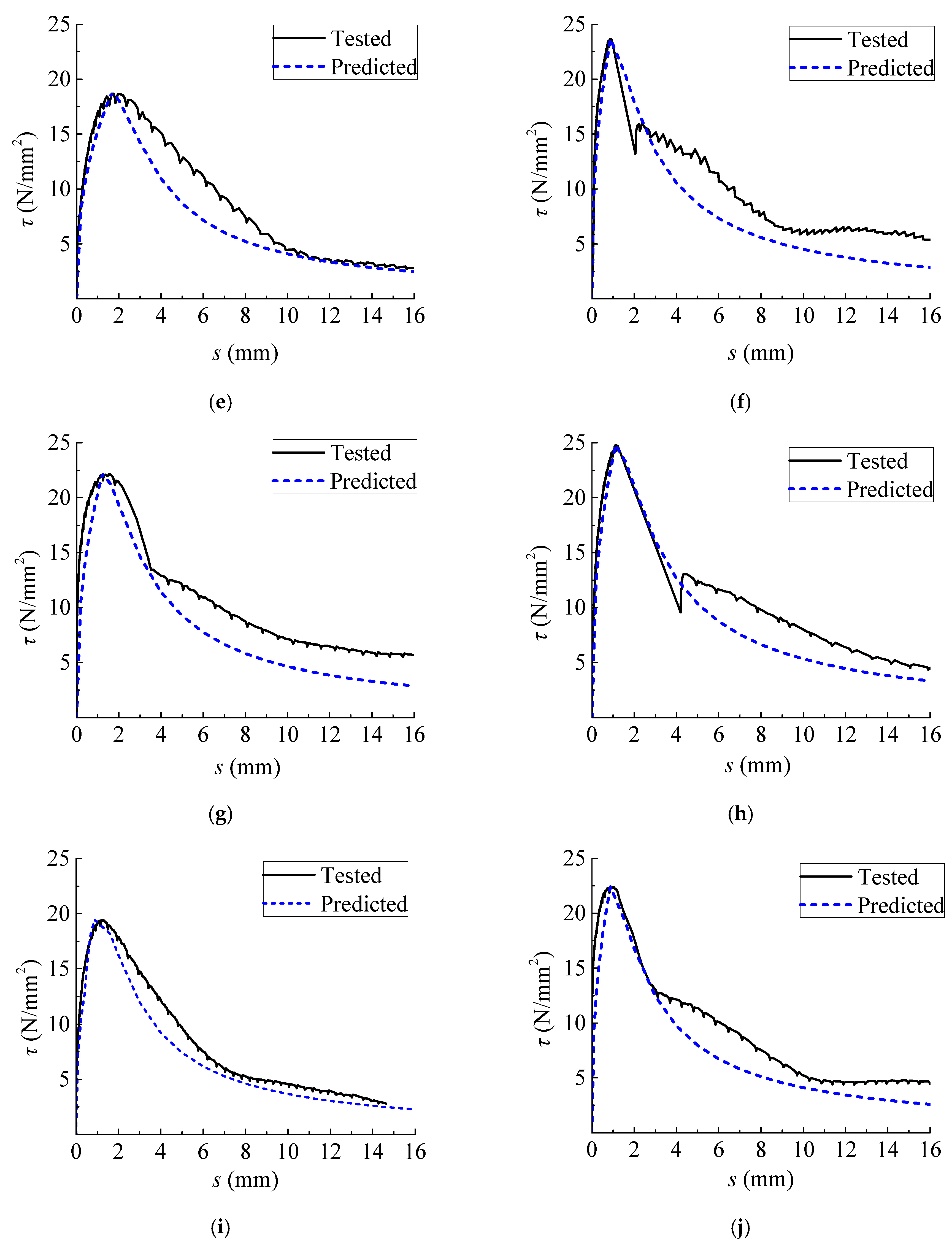
| Grade | Density (kg/m3) | Water Requirement of Standard Consistency (%) | Setting Time (min) | Compressive Strength (MPa) | Flexural Strength (MPa) | |||
|---|---|---|---|---|---|---|---|---|
| Initial | Final | 3 Days | 28 Days | 3 Days | 28 Days | |||
| 32.5 | 3042 | 28.4 | 185 | 320 | 17.8 | 35.0 | 3.20 | 5.56 |
| 42.5 | 3071 | 26.9 | 165 | 265 | 28.9 | 45.2 | 4.00 | 6.70 |
| Group | Designed Cubic Compressive Strength (N/mm2) | Dosage of Raw Materials (kg/m3) | ||||
|---|---|---|---|---|---|---|
| Water | Cement | Gravel | Sand | Water Reducer | ||
| A | 20 | 210 | 350 | 1086 | 754 | 2.45 |
| B | 40 | 165 | 375 | 1172 | 688 | 2.63 |
© 2019 by the authors. Licensee MDPI, Basel, Switzerland. This article is an open access article distributed under the terms and conditions of the Creative Commons Attribution (CC BY) license (http://creativecommons.org/licenses/by/4.0/).
Share and Cite
Song, L.; Qu, F.; Liu, G.; Zhao, S. Bond Properties of Steel Bar in Concrete under Water Environment. Materials 2019, 12, 3517. https://doi.org/10.3390/ma12213517
Song L, Qu F, Liu G, Zhao S. Bond Properties of Steel Bar in Concrete under Water Environment. Materials. 2019; 12(21):3517. https://doi.org/10.3390/ma12213517
Chicago/Turabian StyleSong, Li, Fulai Qu, Guirong Liu, and Shunbo Zhao. 2019. "Bond Properties of Steel Bar in Concrete under Water Environment" Materials 12, no. 21: 3517. https://doi.org/10.3390/ma12213517
APA StyleSong, L., Qu, F., Liu, G., & Zhao, S. (2019). Bond Properties of Steel Bar in Concrete under Water Environment. Materials, 12(21), 3517. https://doi.org/10.3390/ma12213517





